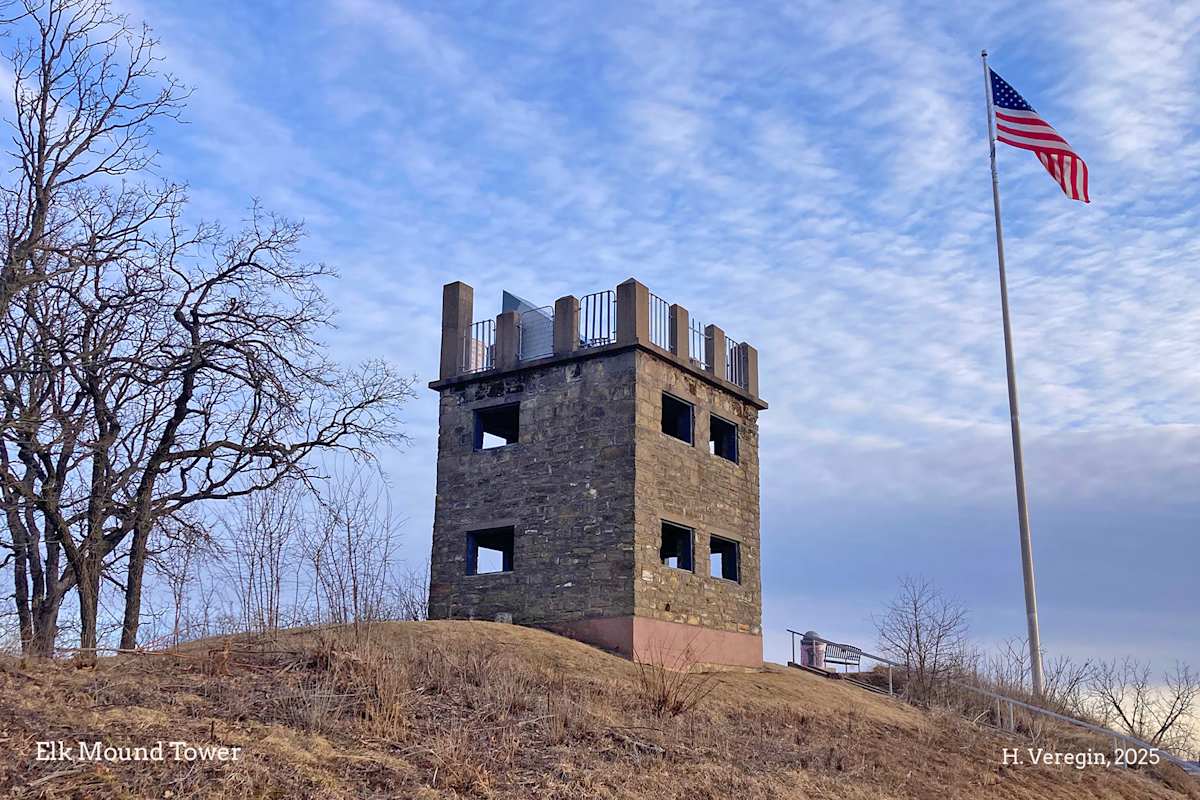A rustic stone tower sits atop a hill on the north side of Elk Mound, a small village in Dunn County. Visible from I-94 just west of Eau Claire, it resembles a 12th-century Norman fortification. Crowned by a crenellated parapet wall, it seems to have been designed to fire projectiles at attacking armies. Did the Normans invade Wisconsin after conquering Britain?
The tower is accessible by an asphalt road. With an elevation gain of 200 feet, the road is steep and surprisingly long. The tower has three stories accessible by metal stairs. The top story is an open viewing area, with metal guard rails between the merlons – the vertical sections between the open crenels. You can see for miles into southern Dunn County. The landscape is agricultural, the small hills and valleys dotted with farm buildings.
The other stories of the tower are empty, the walls of exposed stone. Graffiti marks the surfaces here and there. The date “1938” is chiseled into the concrete lintel above the entrance. A plaque at the base of the tower explains the tower’s purpose. It was built “In memoriam of the deceased rural letter carriers of Dunn County.”
The Village of Elk Mound website provides a brief history. Local farmers constructed a dirt road up the hill sometime after 1924. A flag pole was erected in 1926, purportedly by the contractor who built Highway 12, which now runs parallel to I-94. The property owners deeded the hill to the village and county in 1933, and it became a park. In 1934, Dunn County’s rural letter carriers planted a tree on the hill and set the plaque. Soil from every carrier’s route was placed around the tree.
The tower itself was constructed in 1937 by the county, with help from the Works Progress Administration, a depression-era program to provide employment on public works projects. According to the Village of Elk Mound website, the stones came from a quarry in Downsville, in southern Dunn County, with additional material from a dismantled livery stable in the village.
A dedication ceremony was held on November 11, 1938, and a roll of deceased Dunn County letter carriers was sealed in a granite marker. After the park was given to the village by the county in 1987, the “Social Problems” students at Elk Mound High School, along with local citizens, worked on improvements. The park’s reopening occurred in 1994. A bronze plaque adjacent to the tower gives details. Another plaque states that a new flagpole was raised on November 11th, 2002.
Why a memorial to rural letter carriers? Was Dunn County a particularly dangerous place to deliver the mail? The clue lies in the dates of the dedication ceremony and flagpole raising – November 11. Originally known as Armistice Day, and later renamed Veteran’s Day, November 11 marks the signing – on November 11, 1918 – of the armistice ending German involvement in the First World War. The tower was built as a memorial to Dunn County letter carriers who lost their lives in the war.
The memorial probably owes its existence to the efforts of the Wisconsin Rural Letter Carriers Association. Their website lists only Dane and Dunn Counites as being local units of the association. For some reason lost to history, Dunn County has a particularly strong rural letter carriers organization.
Rural letter delivery officially began in 1902 with RFD, or Rural Free Delivery. (Older readers may remember the 1960s TV show Mayberry RFD , starring Andy Griffith.) It may be hard to imagine, but RFD was the amazon.com of its day. It brought the mail directly to rural farm families, including not only letters, but also catalogs. Sears, Roebuck and Co., established in 1893, was quick to exploit the new service. Their mail-order catalogs offered a huge range of goods, from clothes and shoes, to stoves and farm equipment, to entire houses. Sears Catalog Homes were shipped as kits and assembled on-site, like IKEA furniture but on a massive scale.
RFD was welcomed by rural inhabitants, but it had some negative consequences. Before RFD, families had to travel to their post office, often located in a general store in a nearby community. Collecting the mail also involved purchasing supplies and socializing with neighbors. After RFD, many of these rural post offices closed and communities faded away. Historic maps show this pattern over time, in all corners of the state.
In a sense, Elk Mound Tower memorializes two tragedies – death on the battlefield and the slow, ongoing disintegration of the state’s rural fabric.
Want to be notified of new Oddsconsin posts? Sign up for email alerts here.
